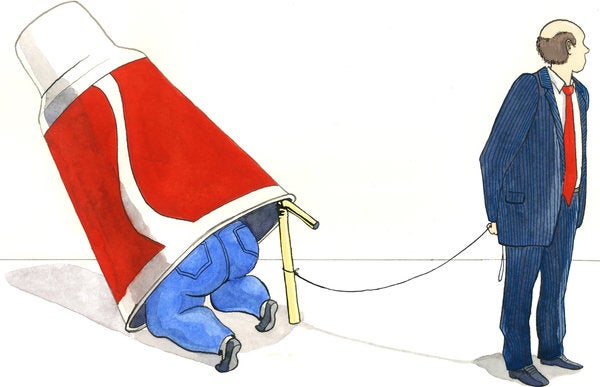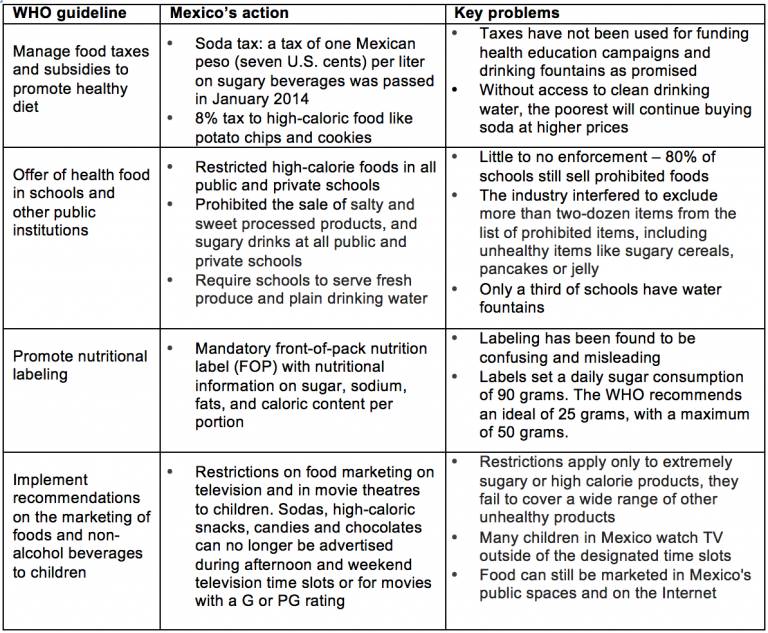 In recent years, the World Health Organization, as well as regional health organizations have developed guidelines and recommendations to deal with the growing obesity epidemic around the world. Many countries are starting to implement measures to meet the objectives set forth by these international bodies. One such country is Mexico. Praised as a pioneer in Latin America, Mexico has managed to tick off many of the boxes recommended by the WHO. Unfortunately, the food and beverage industries have managed to put pressure on the government to the point of rendering them all practically useless.
In recent years, the World Health Organization, as well as regional health organizations have developed guidelines and recommendations to deal with the growing obesity epidemic around the world. Many countries are starting to implement measures to meet the objectives set forth by these international bodies. One such country is Mexico. Praised as a pioneer in Latin America, Mexico has managed to tick off many of the boxes recommended by the WHO. Unfortunately, the food and beverage industries have managed to put pressure on the government to the point of rendering them all practically useless.
Mexico has one of the world’s worst obesity epidemics with nearly three out of every four adults as well as 30% of school children overweight. More than 9% of Mexican adults have been diagnosed with Type 2 diabetes, with the frequency reaching 19% for Mexicans over the age of 50. By some accounts, Mexico consumes more soda per capita than any other country in the world. Not only is an effective obesity prevention strategy necessary to curb Mexico’s growing epidemic, but also to set forth a positive example for the rest of the Latin American region. Measures in Mexico often have a domino effect on the rest of the region—with other countries including Ecuador, Peru and Chile already working on their own measures to reduce the marketing of soft drinks to children, pass soda taxes and improve product labeling.
The following table shows WHO guidelines as well as the actions that Mexico has taken to comply with them. On paper it would appear as if Mexico has a near perfect policy. However if we take a closer look at each measure, we will see that sadly, things aren’t as they appear.

The Soda Tax
The soda tax on its own has had success in lowering the consumption of soda and sugary drinks (the first three months of 2014 saw consumption decline by 10%), and it has increased the purchases of untaxed drinks (milk went up 7% and the purchase of water went up 13%). Additionally it does serve as an educative tax, sending a message from the government to the people that drinking sugary drinks is in fact bad for you. However, the problem lies in the absence of affordable substitutes. Without clean municipal water, many communities over the years have turned to soda as their main source for hydration. If the country’s poorest don’t have access to clean drinking water, they will simply end up spending a larger amount of their already low household budgets on the higher priced sodas.
Revenue from the soda tax was supposed to be earmarked for funding health education programs and drinking fountains in community spaces such as public schools, yet these programs have been underfunded and slow to get off the ground. The Finance Ministry calculated that the beverage tax would raise close to $1 billion of revenue in its first year. Meanwhile, the government plans to allot around $100 million to install water fountains in public schools this year, about a third of the annual amount originally estimated to complete the installations within three years. In the recent years of economic hardship this tax has become more about revenue than obesity. The government has ignored that taxes have to go hand in hand with education campaigns and subsidies for substitutes to avoid hitting the poorest hardest.
The passing of the soda tax also saw the strong influence that the food and beverage industries have in Mexico. When campaigners in the coalition fighting for the tax—the Nutritional Alliance for Health—urged for legislators to pass the tax, soft drink manufacturers retaliated with their own adverts, urging politicians to reject the tax and claiming that the measures would lead to job losses across Mexico’s large sugar and soda industries. They said that small family shops, dependent on soft drinks sales, would close. After pressure from the soda industry, the tax was set at 10% per liter rather than the 20% public health advocates wanted. Additionally campaigners in the coalition tried to buy airtime on the three mainstream television channels, Televisa, TV Azteca and Milenio TV, but were turned down without explanation and suspect advertising contracts with industry were the issue.
Food in schools
Like the soda tax, the industry also managed to interfere with the proposed prohibitions on unhealthy foods in schools. The food industry lobbied successfully to scrap a list of prohibited items from the Mexican guidelines—eliminating more than two-dozen items to be explicitly banned under the guidelines, including pancakes, sugary cereals, jelly, gelatin desserts and canned fruit in syrup.
Additionally, industry is coming out ahead with the lax enforcement of these measures by the Mexican government. The mandatory prohibition of salty and sweet processed products, and sugary drinks at all public and private schools has not been enforced, and a recent study found that up to 80% of schools are still selling sodas and other prohibited items.
To make matters worse, many schools in the public school system lack cafeterias or even water fountains. A recent study found that only a third of schools have water fountains, giving school children few options to substitute the readily available sodas.
Nutritional labeling
In 2014, a new scheme for front-of-package (FOP) labeling was introduced. It was a voluntary directive by the industry that included a FOP nutrition label with nutritional information on sugar, sodium, fats, and caloric content per portion. Because it was found to be too confusing and misleading, the government passed a new mandatory law that will go into effect on July 1st of this year. However, the government produced this label in collaboration with the food industry, with no input from independent public health experts and the new labeling is based on the old voluntary model with only slight changes. A survey undertaken by a consumer group, El Poder el Consumidor, found that the new labeling cannot be understood and is made to confuse consumers; only 1.8% of students majoring in nutrition at university were able to interpret the labeling. Government recommendations say that labeling should be “visible, simple, understandable and quickly read and should lead to the choosing of healthier foods”. The only condition met is that it is visible.
Even worse, the labeling suggests a daily sugar consumption of 90 grams, surpassing the 50-gram maximum recommended by the WHO (they recommend the ideal be no more than 25 grams). The industry managed to ensure that labeling doesn’t show WHO recommended intake labels and does not include percentages of caloric content of each portion in relation to the daily caloric intake.
Restricting food marketing to children
 The last measure to be put in place is the restriction of food marketing to children. Alejandro Calvillo, head of El Poder del Consumidor, says that “It’s an advance, but it falls short”. Unfortunately, the restrictions apply only to extremely sugary or high calorie products. To be truly effective at protecting children from harmful advertising, the threshold for calorie and sugar content needs to be lowered to exclude a broader range of unhealthy foods. Additionally, many young children watch TV in Mexico outside of the restricted time slots, which don’t apply to daytime soap operas and sporting events. There are other loopholes; all manner of packaged food can still be marketed in Mexico’s public spaces and on the Internet. Food and drink companies can also continue to use cartoon characters and toy prizes to attract children.
The last measure to be put in place is the restriction of food marketing to children. Alejandro Calvillo, head of El Poder del Consumidor, says that “It’s an advance, but it falls short”. Unfortunately, the restrictions apply only to extremely sugary or high calorie products. To be truly effective at protecting children from harmful advertising, the threshold for calorie and sugar content needs to be lowered to exclude a broader range of unhealthy foods. Additionally, many young children watch TV in Mexico outside of the restricted time slots, which don’t apply to daytime soap operas and sporting events. There are other loopholes; all manner of packaged food can still be marketed in Mexico’s public spaces and on the Internet. Food and drink companies can also continue to use cartoon characters and toy prizes to attract children.
Time to exclude industry from public health decisions
The recommended measures are an essential step in preventing obesity in Mexico and in other countries, and when implemented effectively, can positively impact the consumption of unhealthy food within a country. However, the Mexican experience illustrates the importance of ensuring that they can be implemented without interference from the very industries that are being regulated. Seemingly minor changes to the laws can end up creating loopholes that undermine the public health goal and render the measure practically useless. Officials of the Ministry of Health and the Mexican equivalent of the FDA have close ties to food companies making it harder to implement objective, evidence-based strategies. However, not all blame can be put on industry; the government has played its part through a complete lack of enforcement, as well as showing plain and simple thoughtlessness towards the country’s most vulnerable populations.
Preventing obesity is not merely a matter of ticking all the boxes, but requires a comprehensive approach, incorporating the country’s specific problems and circumstances when designing the necessary measures. For example, what is being done to ensure that there is an increase in consumption of fruit and vegetables? What is being done to ensure that families are educated about healthy eating? Something has to be done so that those living in desperate poverty have genuine access to healthy foods.
But none of this can be achieved if governments are susceptible to industry influence, or allow industry to be involved in the regulatory process. In Mexico, such an objective, comprehensive approach may be a long time coming. As a start, the government should at least focus on getting these initial measures right—something that can be easily achieved if we choose to focus on the public health rather than succumbing to industry’s wants and needs.
Latest
India and the IHR Amendments: Strengthening Legal Preparedness for Global Health Security
Kashish Aneja Lawrence O. Gostin Sam Halabi



